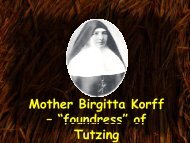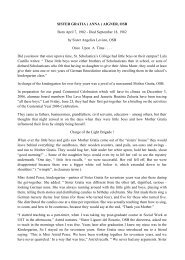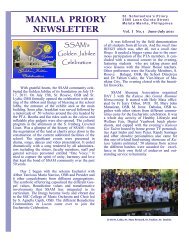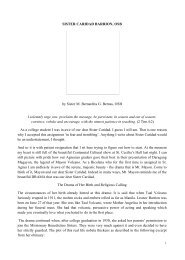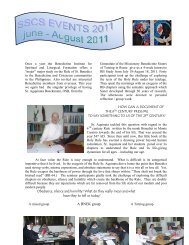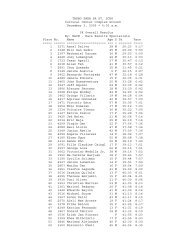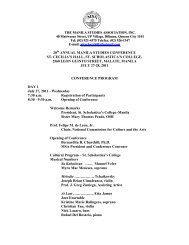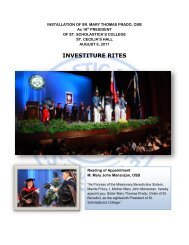Fr. Andreas Amrhein, OSB - St. Scholastica's College
Fr. Andreas Amrhein, OSB - St. Scholastica's College
Fr. Andreas Amrhein, OSB - St. Scholastica's College
Create successful ePaper yourself
Turn your PDF publications into a flip-book with our unique Google optimized e-Paper software.
heavenly glory. This is the true art, the most profound science: to make immortal souls god-like<br />
and pleasing to him.”<br />
“Early in life Josef <strong>Amrhein</strong> manifested a basic generosity, a joy in giving – not only<br />
material but also spiritual gifts.” Perhaps it was also this that led him to consider the priesthood<br />
as a way of sharing his own blessings. “We are very ungrateful and utterly lacking in love. We<br />
have the light, and yet we let millions of others stumble in the darkness.”<br />
In 1866 he went to Karlsruhe to study painting and literature. While he was there “his<br />
priestly vacation became the focus of his thinking.” One Pentecost Sunday, June 9, 1867, Josef<br />
<strong>Amrhein</strong> was awakened by a loud call that clearly said: “Leave everything!” He did not know<br />
for sure whether the experience was a mere “dream, hallucination, or just chance”. However,<br />
“after this Pentecost experience <strong>Amrhein</strong> was sure of his priestly calling.”<br />
Preparing for the Priesthood<br />
In 1868 he moved to Tuebingen to study philosophy and theology. He took great interest<br />
in the lectures of Professor Carl Josef Hefele in a class on church history and Christian<br />
archeology. He was especially impressed by the presentations on religious orders and founders<br />
when it was said that the Christianization of Europe was primarily due to the “peaceful, yet<br />
enduring and blessed labors of the monks of <strong>St</strong>. Benedict.”<br />
The following year, on December 29, 1869, <strong>Amrhein</strong> met for the first time in Tuebingen,<br />
Abbot Maurus Wolter who had refounded Beuron Abbey in 1863. “Seeing Wolter in<br />
Benedictine habit, the young theology student experienced a renewed interest in the<br />
Benedictines.” The following Pentecost (1970) he went for a three-day of retreat in Beuron. He<br />
was very impressed by the solemn liturgy of Beuron and before he left the monastery he<br />
decided to join the monks. “Without doubt it was chiefly his generous heart, ever ready to<br />
follow a call, which prompted <strong>Amrhein</strong>’s quick decision.”<br />
A Monk at the Beuron Abbey<br />
In July 1970 <strong>Amrhein</strong> joined the monks of Beuron Abbey as a candidate and in<br />
December of the same year, he took the name of <strong>Fr</strong>ater <strong>Andreas</strong> as a novice. “On Christmas in<br />
1871 he professed simple perpetual vows, on July 16, 1872, he was ordained a priest, and on<br />
February 2, 1875, he made his solemn profession.”<br />
Writing about <strong>Amrhein</strong>, Sister Bernita Walter raised two crucial questions:<br />
• “Was he aware that Beuron’s monastic life differed considerably from the kind Boniface<br />
and the missionary monks of Germany had lived and which von Hefele’s lectures had<br />
conveyed?<br />
• Had he weighed the fact that his evident vocation to apostolic service would find no<br />
proper expression in Beuron?”<br />
2



